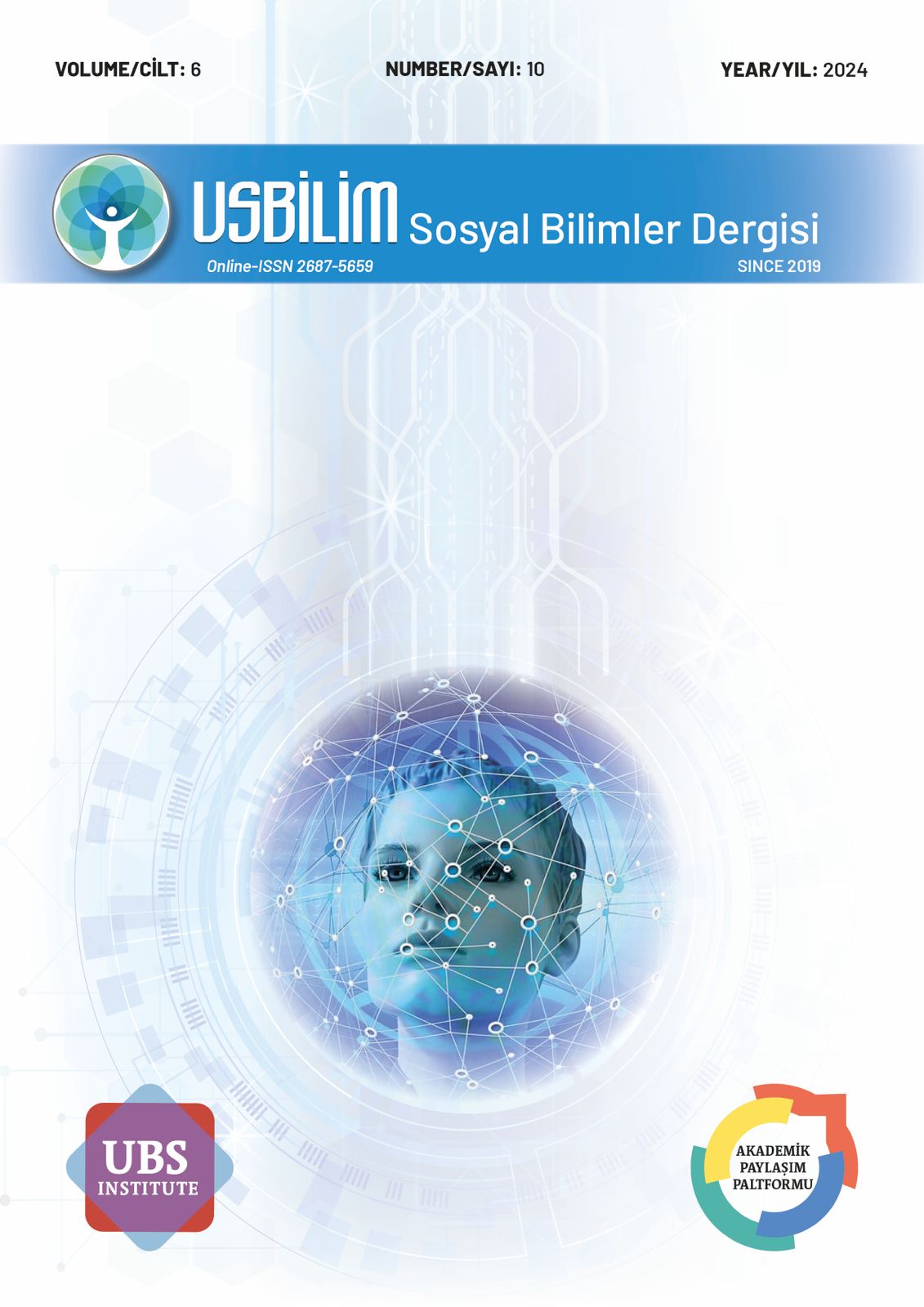MEKÂNA ÖZGÜ SANAT BAĞLAMINDA YAPIT-İZLEYİCİ ETKİLEŞİMİNDE TEKSTİL SANATININ OLANAKLARI
THE POTENTIALS OF TEXTILE ART IN ARTWORK–AUDIENCE INTERACTION WITHIN THE CONTEXT OF SITE-SPECIFIC ART
DOI:
https://doi.org/10.5281/zenodo.17219607Anahtar Kelimeler:
Mekâna özgü sanat, tekstil sanatı, izleyici etkileşimi, dijitalleşme, kültürel bellekÖzet
Bu çalışma, mekâna özgü sanat bağlamında tekstil sanatının izleyiciyle kurduğu etkileşimsel ve çok boyutlu ilişkileri disiplinlerarası bir bakış açısıyla incelemektedir. Araştırma, sanatsal bir ifade aracı olarak tekstilin duyusal, kültürel, teknolojik ve toplumsal boyutlarını kuramsal tartışmalar ve uluslararası düzeyde seçilmiş vaka örnekleri üzerinden ele almaktadır. Uluslararası seçkide, Janet Echelman’ın kamusal ölçekli ağ enstalasyonları, Do Ho Suh’un göç hafızasını çağrıştıran şeffaf kumaş mimari yapıları, Ernesto Neto’nun bedensel katılımı teşvik eden organik tekstil formasyonları, Refik Anadol’un veri temelli dijital yüzey projeksiyonları, teamLab’in sürükleyici mekânsal deneyimleri ve urban knitting gibi katılımcı pratikler, tekstilin sanatsal bağlamda sunduğu olanakları görünür kılan örnekler olarak analiz edilmiştir. Bulgular, tekstilin mekâna özgü sanatta üç temel rol üstlendiğini göstermektedir. Bunlar sırasıyla, izleyiciye duyusal ve bedensel katılım imkânı sağlamak, kültürel bellek ve kimlik katmanlarını görünür kılmak, toplumsal bağları güçlendiren kolektif süreçlere aracılık etmek olarak tanımlanabilir. Dijitalleşme ve yeni medya teknolojileri ise, bu işlevleri fiziksel mekânın sınırlarının ötesine taşıyarak sanal ortamlarda yeniden üreterek estetik deneyimi genişletmektedir. Çalışma, tekstilin mekâna özgü sanatta yalnızca malzeme değil, aynı zamanda estetik, kültürel ve iletişimsel bir ara yüz olarak konumlandığını ortaya koymakta; sanatçılar, küratörler ve araştırmacılar için hem kuramsal hem de uygulamalı düzeyde yeni perspektifler sunmaktadır.
Referanslar
Andrew, S. (2008). Textile semantics: Considering a communication-based reading of textiles. Textile. The Journal of Cloth & Culture, 6(1), 32-65. https://doi.org/10.2752/175183508X375290
Andrew, S. (2013). The medium carries the message? Perspectives on making and viewing textiles. Journal of Visual Art Practice, 12(2), 195-221. https://doi.org/10.1386/jvap.12.2.195_1
Auther, E. (2008). Fiber art and the hierarchy of art and craft 1980–80. The Journal of Modern Craft, 1(1), 13-34. https://doi.org/10.2752/174967808783489442
Bishop, C. (2012). Artificial hells: Participatory art and the politics of spectatorship. Verso.
Bourriaud, N. (1998). Relational aesthetics. Les presses du réel.
Bourriaud, N. (2005). Postproduction: Culture as screenplay: How art reprograms the world. Lukas & Sternberg.
Buschmeier, A. (2013). Interactive art: Practices and debates. Transcript Verlag.
Echelman, J. (2014). As if it were already here [Public art installation]. Rose Kennedy Greenway Conservancy. https://www.echelman.com/project/as-if-it-were-already-here
Echelman, J. (2018). Sculpting public space. Oz, 40(6), 18-22.
Flyvbjerg, B. (2006). Five misunderstandings about case-study research. Qualitative Inquiry, 12(2), 219-245. https://doi.org/10.1177/1077800405284363
Göçmen, E. C. (2019). Mekân ve izleyici bağlamında çağdaş sanat yapıtında etkileşim. Yüksek lisans tezi, Sakarya Üniversitesi, Sakarya.
Grau, O. (2003). Virtual art: From illusion to immersion. MIT Press.
Haveri, M. (2013). Urban knitting: The soft side of street art. Synnyt/Origins: Finnish Studies in Art Education, 2, 1-19.
Hayeur-Smith, M. (2012). Weaving wealth: Cloth and trade in Viking Age and Medieval Iceland. SAXO Institute, University of Copenhagen.
Helgadottir, G. (2011). Nation in a sheep’s goat: The Icelandic sweater. Form Akademisk, 4(2), 59-68. https://doi.org/10.7577/formakademisk.171
Jakobson, R. (1987). Language in literature. Harvard University Press.
Karppinen, S. (2008). Craft-art as a basis for human activity. International Journal of Art & Design Education, 27(1), 83–90. https://doi.org/10.1111/j.1476-8070.2008.00558.x
Kwon, M. (2002). One place after another: Site-specific art and locational identity. MIT Press.
Luutonen, M. (2008). Handmade memories. Trames: A Journal of the Humanities & Social Sciences, 12(3), 331-341. https://doi.org/10.3176/tr.2008.3.08
Merleau-Ponty, M. (1962). Phenomenology of perception (C. Smith, Trans.). Routledge & Kegan Paul. (Original work published 1945)
Nimkulrat, N. (2010). Material inspiration: From practice-led research to art education. Craft Research, 1(1), 63–84. https://doi.org/10.1386/craft.1.1.63/1
Norman, D. A. (2005). Emotional design: Why we love (or hate) everyday things. Basic Books.
Norman, D. A. (2013). The design of everyday things (Revised and expanded ed.). Basic Books.
Panofsky, E. (1972). Studies in iconology. Harper & Row.
Papanek, V. (1971). Design for the real world: Human ecology and social change (2nd ed.). Pantheon.
Papanek, V. (1995). The green imperative: Ecology and ethics in design and architecture. Thames & Hudson.
Paul, C. (2015). Digital art (3rd ed.). Thames & Hudson.
Peirce, C. S. (1958). Collected papers of Charles Sanders Peirce: Vols. 7–8. Harvard University Press.
Petti, L., Trillo, C., & Makore, B. N. (2020). Cultural heritage and sustainable development targets: A possible harmonisation? Insights from the European perspective. Sustainability, 12(926), 1-15. https://doi.org/10.3390/su12030926
Pöllänen, S. (2011). Beyond craft and art: A pedagogical model for craft as self-expression. International Journal of Education through Art, 7(3), 111–125. https://doi.org/10.1386/eta.7.3.111_1
Pöllänen, S. (2015). Elements of crafts that enhance well-being: Textile craft makers’ descriptions of their leisure activity. Journal of Leisure Research, 47(1), 58-78. https://doi.org/10.1080/00222216.2015.11950354
Quaranta, D. (2013). Beyond new media art. Link Editions.
Refik Anadol Studio. (2018). Machine hallucinations [Art installation]. Refik Anadol Studio. https://refikanadol.com
Rhodes, G. A. (2014). Augmented reality in art: Aesthetics and material for expression. In V. Geroimenko (Ed.), Augmented reality art (pp. 127–137). Springer. https://doi.org/10.1007/978-3-319-06203-7_10
Rose, G. (2001). Visual methodologies: An introduction to the interpretation of visual materials. Sage.
Serrao, F., Chirico, A., Gabbiadini, A., Gallace, A., & Gaggioli, A. (2024). Enjoying art: An evolutionary perspective on the aesthetic experience from emotion elicitors. Frontiers in Psychology, 15, 1341122. https://doi.org/10.3389/fpsyg.2024.1341122
Shenton, A. K. (2004). Strategies for ensuring trustworthiness in qualitative research projects. Education for Information, 22(2), 63-75. https://doi.org/10.3233/EFI-2004-22201
TeamLab. (2015). Teamlab borderless [Digital art museum]. Mori Building Digital Art Museum. https://www.teamlab.art/e/borderless/
Tiffany, S. (2004). Frame that rug: Narratives of Zapotec textiles as art and ethnic commodity in the global marketplace. Visual Anthropology, 17(3-4), 293-318. https://doi.org/10.1080/08949460490888556
İndir
Yayın Tarihi
Nasıl Atıf Yapılır
Sayı
Bölüm
Lisans
Telif Hakkı (c) 2025 Usbilim Sosyal Bilimler Dergisi

Bu çalışma Creative Commons Attribution 4.0 International License ile lisanslanmıştır.



